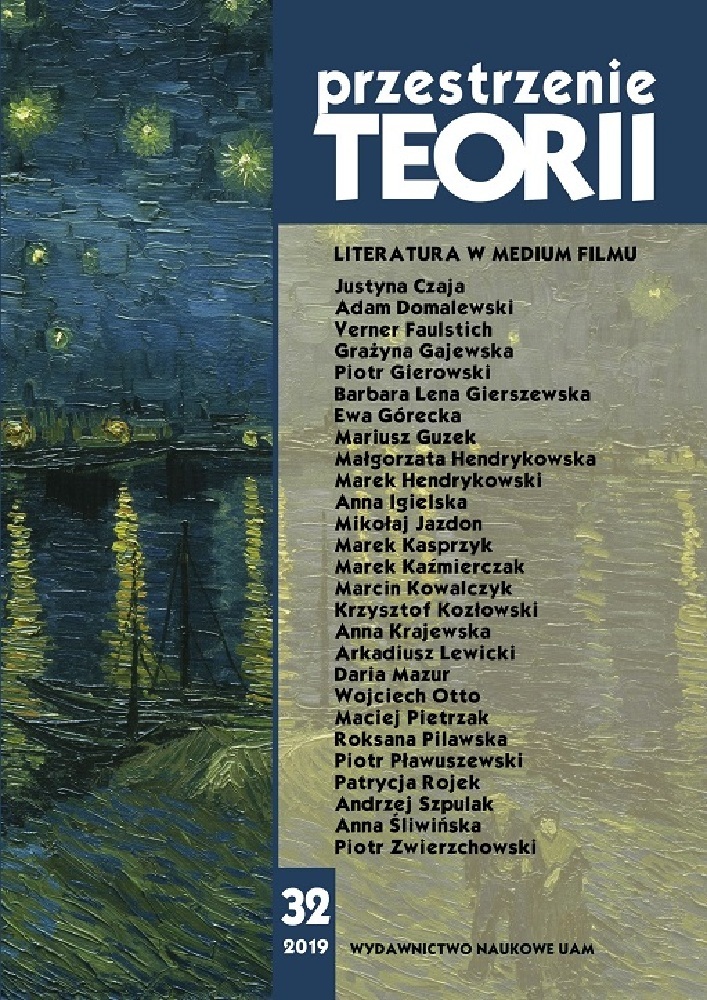Abstrakt
Domalewski Adam, Portret młodego pisarza oraz nawiązania do twórczości Antona Czechowa w Dzikiej gruszy Nuriego Bilge Ceylana [Portrait of a Young Writer and References to European Literature in Nuri Bilge Ceylan’s The Wild Pear Tree]. „Przestrzenie Teorii” 32. Poznań 2019, Adam Mickiewicz University Press, pp. 343–355. ISSN 1644-6763. DOI 10.14746/pt.2019.32.18.
The article focuses on topics related to literature, especially to the works of Anton Chekhov, in the latest film by Nuri Bilge Ceylan The Wild Pear Tree. Its main character, Sinan, is a young writer, while the film is set in the province of Çanakkale, where ancient Troy was located. The analysis of the picture shows that the director refers to the historicity of the myth of the Trojan War with distrust. Instead, Ceylan portrays a local community immersed in intellectual stagnation and creates his hero as an extremely unlikeable misanthropist, to whom literature cannot bring fulfillment. The character of his father, Idris, introduces another ancient motif to the film – the figure of Sisyphus. The relationship between father and son, which deepens in the finale, brings an unexpected note of optimism to the picture, which in its dramaturgy resembles Anton Chekhov’s literary worlds.
Bibliografia
Atam Z., The Existential Boundaries of Nuri Bilge Ceylan’s Cinema: “In the Beginning Was the Father, Why Papa?”, [w:] New Cinema, New Media: Reinventing Turkish Cinema, ed. by M. Akser, D. Bayrakdar, Cambridge 2014.
Czechow A., Wybór dramatów, przeł. N. Gałczyńska, Wrocław 1979.
Diken B., Gilloch G., Hammond C., The Cinema of Nuri Bilge Ceylan. The Global Vision of a Turkish Filmmaker, London–New York 2018.
Kasman D., Cannes 2018. Correspondences #11: The Dead, the Kyrgyz, and the Writer <https://mubi.com/notebook/posts/cannes-2018-correspondences-11-the-dead-the-kyrgyz-and-the-writer> [dostęp: 27.08.2019].
Kempna-Pieniążek M., Nuri Bilge Ceylan: dalekie miejsca i bliskie twarze, [w:] Autorzy kina europejskiego VII, red. P. Włodek, K. Żyto, Łódź 2018.
Kolb F., Zmanipulowana ‹‹Troja››. Historia – Mity – Polityka, przekł. L. Mrozewicz, A. Pawlicka, Gniezno 2016.
Ksenicz A., Ścieżkami bohaterów Antona Czechowa, Zielona Góra 2007.
McConnel A., Reflections (1) on Nuri Bilge Ceylan’s “Ahlat Ağacı” (The Wild Pear Tree),
<http://www.serbestiyet.com/yazarlar/adam-mcconnel/reflections-1-on-nuri-bilge-ceylans-ahlat-agaci-the-wild-pear-tree-846894> [dostęp: 27.08.2019].
Polotskaya E., Chekhov and his Russia, [w:] The Cambridge Companion to Chekhov, ed. by V. Gottlieb, P. Allain, Cambridge 2000.
Raw L., Nuri Bilge Ceylan: Rediscovering Anatolia, [w:] tegoż, Six Turkish Filmmakers, Wisconsin 2017.
Shakh-Azizova T., Chekhov on the Russian Stage, [w:] The Cambridge Companion to Chekhov, ed. by V. Gottlieb, P. Allain, Cambridge 2000.
Suner A., New Turkish Cinema. Belonging, Identity and Memory, London–New York 2010.
Whyman R., Anton Chekhov, Routledge, London and New York 2011.
Zıraman Z.C., European Co-Productions and Film Style: Nuri Bilge Ceylan, “Studies in European Cinema” 2019, vol. 16, no. 1.
Licencja
Autorzy
Autorzy tekstów przyjętych do publikacji w czasopiśmie „Przestrzeniach Teorii” są zobowiązani do wypełnienia, podpisania i odesłania na adres redakcji umowy o udzielenie nieodpłatnej licencji do utworów, z zobowiązaniem do udzielania sublicencji CC.
Zgodnie z umową, autorzy tekstów opublikowanych w czasopiśmie „Przestrzeniach Teorii” udzielają Uniwersytetowi im. Adama Mickiewicza w Poznaniu niewyłącznej i nieodpłatnej licencji oraz zezwalą na użycie sublicencji Creative Commons Attribution-NonCommercial-NoDerivatives 4.0 International (CC BY-NC-ND 4.0).
Autorzy zachowują prawa do dalszego, swobodnego rozporządzania utworem.
Autorzy, którzy wykorzystują w swoim tekście cudze utwory (np. ilustracje, fotografie) proszeni są o dostarczenie do redakcji czasopisma zgodę na publikację od uprawnionych podmiotów.
Użytkownicy
Zainteresowani użytkownicy internetu uprawnieni są do korzystania z utworów opublikowanych po 2015 roku „Przestrzeniach Teorii” tylko w calach niekomercyjnych, pod następującymi warunkami:
- uznanie autorstwa - obowiązek podania wraz z rozpowszechnionym utworem, informacji, o autorstwie, tytule, źródle (odnośniki do oryginalnego utworu, DOI) oraz samej licencji;
- bez tworzenia utworów zależnych - utwór musi być zachowany w oryginalnej postaci, nie można bez zgody twórcy rozpowszechniać np. tłumaczeń, opracowań.
Do wszystkich tekstów opublikowanych przed 2015 r. prawa autorskie są zastrzeżone.
Inne
Uniwersytet im. Adama Mickiewicza w Poznaniu zachowuje prawo do czasopisma jako całości (układ, forma graficzna, tytuł, projekt okładki, logo itp.).

